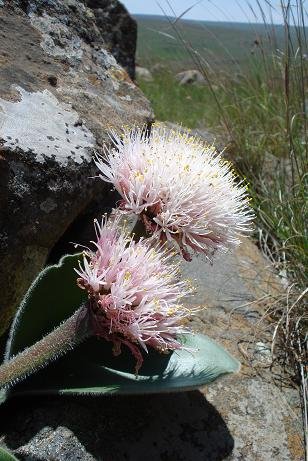Haemanthus humilis subsp. hirsutus

Author: Ivan Lätti
Photographer: Judd Kirkel Welwitch
Haemanthus humilis subsp. hirsutus is a perennial bulbous plant of the Amaryllidaceae family that reaches about 30 cm in height when flowering. Being deciduous, it grows usually two, sometimes three semi-erect leaves and a flower scape annually. Some Afrikaans names for this geophyte, like bobbejaanoor (baboon ear) and velskoenblaar (home made leather shoe leaf) do not sound flattering. They do, however, constitute the often apt descriptions of interested people with no pretence at science that frequent the veld and note the features of plants.
And these names may be no more confusing than the series of botanical name changes this plant, like many plants, has undergone. The names Haemanthus hirsutus and H. candidus are still around in some sources. The histories record milestones in knowledge growth about species. Collectively the bits and pieces assume lives of their own, often chapters in semi-disclosed narratives. Every milestone appears in a different publication, in its time the latest on its subject. Even the mistakes are retained for the full stories. Later searches do complicate life for those pursuing paper trails. Curiosity can be bane or boon of digger and delver lives. Knowledge is king!
The white to pale pink, dome-shaped flowerheads of the hairy subspecies of H. humilis grow on sturdy and, of course, hairy stalks and particularly leaves justifying the hirsute component of the name.
One finds these plants in the eastern and northeastern parts South African summer rainfall area, from the Eastern Cape, the Free State and KwaZulu-Natal to Gauteng and Mpumalanga.
Much of this region is high altitude, grassland, the plants growing on south-facing rocky slopes. It becomes cold and dry in winter here. The habitat population is deemed of least concern early in the twenty first century (Duncan, et al, 2016; Manning, 2009; iNaturalist; http://redlist.sanbi.org).

